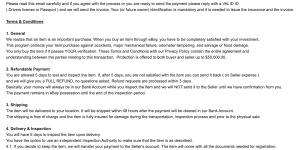Consumer advocate CHOICE said cons ranging from fake crypto investment schemes to romance scams cost Australians.

Scam victim Ellen Dickinson.Nick Moir/ The Sydney Morning Herald
But a CHOICE spokesman said most people turning to crowdfunding only got back a fraction of their loss. “Some victims are also using TikTok to raise awareness of their situations,” a spokesman said.
Ellen Dickinson,an 18-year-old university law student from Baulkham Hills,said she received about $870 in public donations through her crowdfunding effort after she unwittingly transferred nearly $5000 to a fake online car seller to buy her first car. She had responded to an advertisement for a Suzuki Swift on a social media website.
“We transferred the amount to a personal bank account and the car was supposed to come 48 hours after that,” she said.
When the car failed to arrive,Dickinson tried to call a provided customer service number only to find it was disconnected. She later discovered other complaints made online about the same scam.

Information provided by the fake car seller to Ellen Dickinson.Supplied
The Australian Competition and Consumer Commission (ACCC) has identified bank transfer as the most common payment method for scams,accounting for - a 32 per cent increase compared to $97 million lost in 2020.
The by using technology that monitors bank transfers,checks the name of the payee is authentic,and matches their bank account details. Victims are also given a of money lost.
Its recent brief to the federal government says:“There are examples of codes in the UK that provide increased protections to victims of scams and better scam prevention in the financial sector.”
A Victorian retiree,who did not want his name published,toldThe Sydney Morning Herald andThe Age he had lost nearly $20,000 in a computer scam and his bank was only able to return half the money as a “goodwill gesture”.

CHOICE consumer advocate Patrick Veyret said banks have an important role to play in preventing losses to victims of scammers,particularly through bank transfers.
“Implementing Confirmation of Payee (CoP) technology and adopting an industry-wide code of practice are two things they could do right now that would reduce harm to consumers and make scams less profitable,” Veyret said.
CHOICE said the adoption of CoP by the six largest banks in the UK in 2019 led to a 35 per cent fall in the value of misdirected payments to scammers and other unintended recipients. Measures also included contingent reimbursement to fraud victims who had not been negligent in transferring funds to scammers.
Consumer Action Law Centre chief executive officer Gerard Brody has called for the UK approach to be adopted in Australia.
“We’re calling on the federal government to have some mandatory rules in place,either through legislation or regulation,when it comes to these obligations,” he said.
“People might assume that banks are checking because often they ask you to enter the account name,but they’re not actually doing any sort of confirmation check to make sure the account numbers you enter are linked to that account name,” he said.
The Australian Banking Association (ABA) said overseas industry codes limited to banks had failed to significantly reduce the impact of scams. The ABA supports a broader strategy across all sectors including online shopping platforms,telco providers,governments and law enforcement agencies.
“The ABA recommends any proposed regulation in Australia must ensure that all sectors are part of the solution rather than regulation on one sector alone,” an ABA spokesman said.
Westpac,NAB and CBA said they have systems in place to try to prevent scams and retrieve money for customers where possible. Reimbursement of lost money was considered on a case-by-case basis when the fraud was unauthorised.
Chris Sheehan,who leads NAB’s investigations and fraud portfolio,said once funds had left a victim’s account,it was often difficult to recover them.
“We are observing developments in the UK and other countries closely... it is clear from the evidence that reimbursement programs in isolation will not solve the complex scams challenges we face in Australia,” he said.
“We need to address the problem,and that is to stop the crime. That requires a comprehensive public and private sector response spanning across different business sectors including telcos,social media companies and banks to keep our community safe to address the issue. No one sector or organisation can stop this - there is no silver bullet.”
The ACCC’s Scamwatch reported nearly $1.8 billion in losses through scams last year but estimates the real figure including those that are not reported.